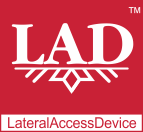
LateralAccessDevice
takes you back to before the Internet
How It Works | Download LAD | Support | LAD Security | Features & Uses | Resources | Members | User Guide
Trust in the Digital Age: Working from Home on a Company LaptopYou have been provided a computer by your company. They trust you enough to work from home without direct supervision. You dot all your i’s and cross all your t’s, making sure to keep the company computer just for work, taking care not to let private stuff creep from your home computers to your work computer and vice versa. You have earned the trust afforded you, logging on and working during working hours, then closing it all up when done for the day. But wait. What is actually installed on that company laptop? How far does your company’s trust of you extend? Even a computer non-expert may quickly find that the work computer is set up so that the employee-user cannot change the settings or drivers. While this make sense to a certain extent, as corporate IT departments would be unable to provide much technical support to computers outside of the office and would not want the users to render their computers unusable by messing with the settings, on the other hand, why would they not let you turn off or disable built-in microphone and webcam when you don’t need them? On the suspicious side, this makes it impossible for you to limit the inadvertent (or advertent) data collection capabilities of the computer unless you physically remove or disconnect the microphone and camera hardware. Further, you may also find that the company laptop mysteriously starts flickering its lights when not in use, even when closed and supposedly "sleeping," indicating that the computer is remotely activatable, perhaps in the name of corporate security or for technical updates and configurational changes. But how do you know? It’s no pleasant thing to find out that your company could be monitoring you at home 24/7 via the audio and video hookups without your cognizance or permission, just so you or they could have the convenience of you being able to work from home, and you don’t have a way to turn those audio and video hookups off. While in the past putting a bandaid over the camera and microphone was a popular remedy, the computer microphones can actually be surprisingly sensitive and still capture audio despite a bandaid or other covering (we have tested this). And, there may be more than one microphone in the computer chassis. Unless you keep the computer in a room separate from the rest of your household and with the door closed, the microphone could pick up the sounds of your spouse chatting on the phone in the next room or preparing dinner in the kitchen. This is problematic even if your company has no intentions with regards to the computer’s webcam or microphone, because these capabilities could also be exploited by hackers. While you hope that your company would never get hacked, it happens all the time to organizations of all sizes and in any department, including IT and cybersecurity. Then you have the scenario of malware and spyware being served to your work-at-home computer through its remote update capabilities (that you cannot disable) and images and audio of you and your family reaching the world through the webcam and microphone that you cannot disable. Skeptical? See if you can remove or disable the audio capability of your company-issued laptop without physically disconnecting the hardware. In some cases you merely may not be able to change the driver setting, but in other cases you may find that although the driver’s status shows as disabled, the computer still picks up the audio. We tested exactly that on a typical laptop used in a corporate or education setting and found that even though the microphone's driver was supposedly disabled, the audio recording program was still able to detect and record audio from the microphone. A sneakier step further are the computers that don’t even list the drivers, begging the question of what else is hidden from you. In those circumstances, the only way to tell what someone else may be picking up about you from your computer is to use an external device, such as our LateralAccessDevice, to see what data and communications are leaving your work computer, and where they are going.
|